Nanorobotics is the emerging technology field of creating machines or robots whose components are at or close to the microscopic scale of a nanometer. More specifically, nanorobotics refers to the nanotechnology engineering discipline of designing and building nanorobots, with devices ranging in size from 0.1-10 micrometers and constructed of nanoscale or molecular components. The names nanobots, nanoids, nanites, nanomachines or nanomites have also been used to describe these devices currently under research and development.
 By 2020, scientists at Rutgers University believe that nanorobots will be injected into the bloodstream and administer a drug directly to an infected cell. This nanorobot has a carbon nanotube body, a biomolecular motor that propels it and peptide limbs to orient itself. Because it is composed of biological elements such as DNA and proteins, it will be easily removed from the body.(Image courtesy of the Bio-Nano Robotics team at Rutgers University: Constantinos Mavroidis, Martin L. Yarmush, Atul Dubey, Angela Thornton, Kevin Nikitczuk, Silvina Tomassone, Fotios Papadimitrakopoulos and Bernie Yurke.)
By 2020, scientists at Rutgers University believe that nanorobots will be injected into the bloodstream and administer a drug directly to an infected cell. This nanorobot has a carbon nanotube body, a biomolecular motor that propels it and peptide limbs to orient itself. Because it is composed of biological elements such as DNA and proteins, it will be easily removed from the body.(Image courtesy of the Bio-Nano Robotics team at Rutgers University: Constantinos Mavroidis, Martin L. Yarmush, Atul Dubey, Angela Thornton, Kevin Nikitczuk, Silvina Tomassone, Fotios Papadimitrakopoulos and Bernie Yurke.)
Nanorobots are theoretical microscopic devices measured on the scale of nanometers (1nm equals one millionth of 1 millimeter). When fully realized from the hypothetical stage, they would work at the atomic, molecular and cellular level to perform tasks in both the medical and industrial fields that have heretofore been the stuff of science fiction.
A few generations from now someone diagnosed with cancer might be offered a new alternative to chemotherapy, the traditional treatment of radiation that kills not just cancer cells but healthy human cells as well, causing hair loss, fatigue, nausea, depression, and a host of other symptoms. A doctor practicing nanomedicine would offer the patient an injection of a special type of nanorobot that would seek out cancer cells and destroy them, dispelling the disease at the source, leaving healthy cells untouched. Nanomachines are largely in the research-and-development phase, but some primitive molecular machines have been tested.
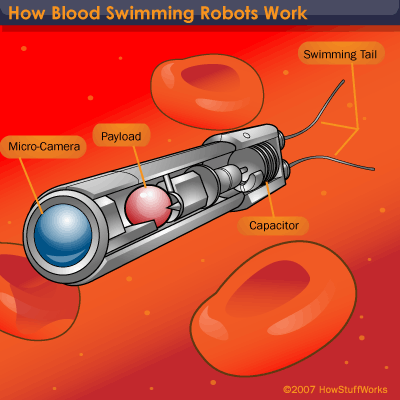 Nanorobots are theoretical microscopic devices measured on the scale of nanometers
Nanorobots are theoretical microscopic devices measured on the scale of nanometers
The first useful applications of nanomachines might be in medical technology, which could be used to identify and destroy cancer cells. Recently, Rice University has demonstrated a single-molecule car developed by a chemical process and including buckyballs for wheels. Although nanotech processes occur at the scale of nanometers, the materials and objects that result from these processes can be much larger. Large-scale results happen when nanotechnology involves massive parallelism in which many simultaneous and synergistic nanoscale processes combine to produce a large-scale result.
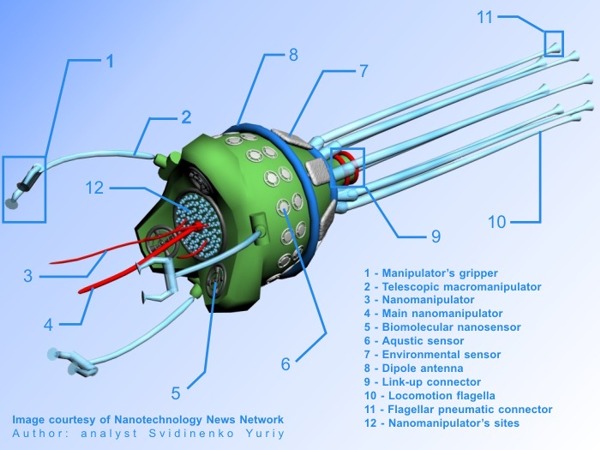 Diamondoid cell-repair nanorobot
Diamondoid cell-repair nanorobot
Nanotechnology spans and merges disciplines dealing with matter at the micro level (physics, chemistry, and biology) with those dealing with matter at the macro level (engineering, materials science and computer science). A nanorobot is a tiny machine designed to perform a specific task or tasks repeatedly and with precision at nanoscale dimensions, that is, dimensions of a few nanometers (nm) or less, where 1 nm = 10-9 meter. Nanorobots have potential applications in the assembly and maintenance of sophisticated systems. Nanorobots might function at the atomic or molecular level to build devices, machines, or circuits, a process known as molecular manufacturing.
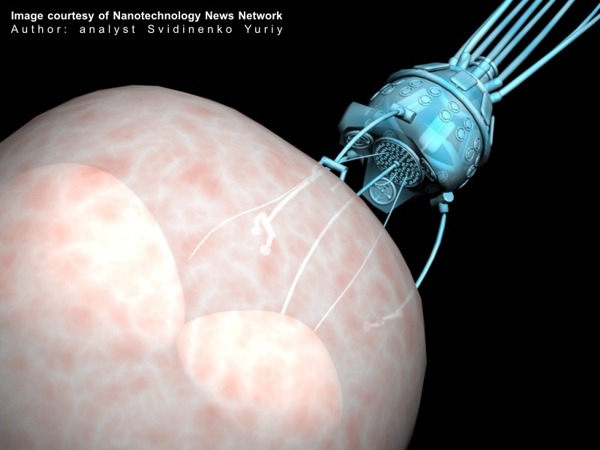 Nanorobot performing cell surgery
Nanorobot performing cell surgery
Nanorobots might also produce copies of themselves to replace worn-out units, a process called self-replication. Nanorobots are of special interest to researchers in the medical industry. Nanoscale systems can also operate much faster than their larger counterparts because displacements are smaller; this allows mechanical and electrical events to occur in less time at a given speed.
Human knowledge, with all its growth and development, is still in its initial stages of finding efficient ways to treat cancer. The elevated number of cancer patients puts cancer treatment amongst the top priority of scientific research facilities. The advent of nanotechnology opens new windows that promise effective ways in locating the chemical sources, tracking them, controlling the cancerous cells, and finally terminating them.
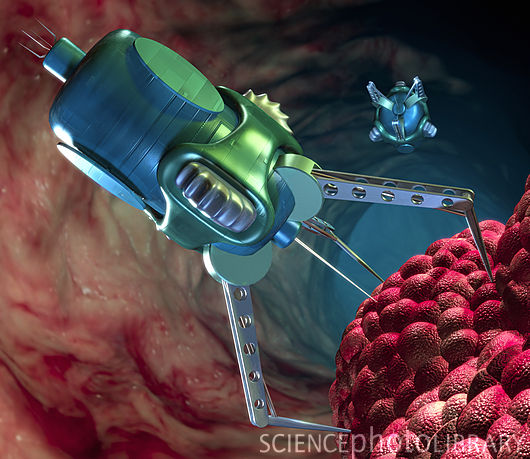 Nanorobot attacking cancer
Nanorobot attacking cancer
Cancerous cells replicate faster than healthy cells, causing strain in the nutrient supply and in the elimination of metabolic waste products. Due to the fast growth of the cancer cells, the healthy cells cannot compete for adequate nutrients, and will eventually be replaced by tumor cells. At some point the tumor growth rate will reach a steady state where the rate of cell death will equal the rate of cell proliferation, and stay in steady state until the tumor finds better access to the circulatory system. A decisive factor in determining the patient’s chance of survival is how early the cancerous cells are detected.
An important aspect in cancer therapy is the development of a targeted drug delivery system that decreases the toxic side effects of chemotherapy. The current conventional method in treating cancer involves inserting catheters to allow for chemotherapy, to reduce the amount of cancer present, and then to surgically remove the tumors, followed by more chemotherapy and radiation sessions. Nanorobots navigate as bloodborne devices, so they can be utilized to help diagnose the cancer in its early stages and participate in smart drug delivery.
Since nanorobots would be microscopic in size, it would probably be necessary for very large numbers of them to work together to perform microscopic and macroscopic tasks. The joint use of nanoelectronics, photolithography, and new biomaterials provides a possible approach to manufacturing nanorobots for common medical applications, such as for surgical instrumentation, diagnosis and drug delivery. Nubots are synthetic robotics devices at the nanoscale. Representative nubots include the several DNA walkers reported by Nadrian Seeman’s group at NYU, Niles Pierce’s group at Caltech, John Reif’s group at Duke University, Chengde Mao’s group at Purdue, and Andrew Turberfield’s group at the University of Oxford.
Nanofactory Collaboration, founded by Robert Freitas and Ralph Merkle in 2000 and involving 23 researchers from 10 organizations and 4 countries, focuses on developing a practical research agenda specifically aimed at developing positionally-controlled diamond mechanosynthesis and a diamondoid nanofactory that would have the capability of building diamondoid medical nanorobots. The use of electromagnetic fields are normally applied to control the motion of this kind of biological integrated device.
A document with a proposal on nanobiotech development using open technology approaches has been addressed to the United Nations General Assembly. In the same ways that technology development had the space race and nuclear arms race, a race for nanorobots is occurring. There is plenty of ground allowing nanorobots to be included among the emerging technologies.
Some of the reasons are that large corporations, such as General Electric, Hewlett-Packard and Northrop Grumman have been recently working in the development and research of nanorobots, surgeons are getting involved and starting to propose ways to apply nanorobots for common medical procedures, universities and research institutes were granted funds by government agencies exceeding $2 billion towards research developing nanodevices for medicine, bankers are also strategically investing with the intent to acquire beforehand rights and royalties on future nanorobots commercialization. A large number of patents has been granted recently on nanorobots, done mostly for patent agents, companies specialized solely on building patent portfolio, and lawyers.
You might also like
| What is Nanoelectronic ? Nanoelectronics refer to the use of nanotechnology... | Nanomedicine - the Future Medicine Nanomedicine is the medical application of... | Nanomaterials - the Future Technology Nanomaterials is a field that takes a materials... | Welding Welding is a fabrication or sculptural... |


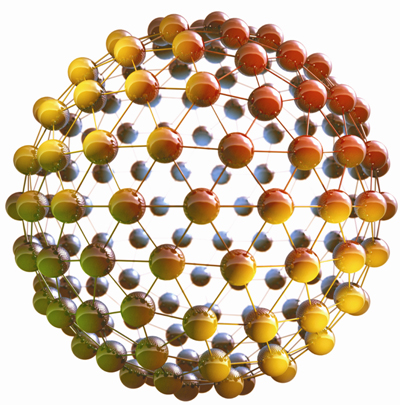

 Alloy Suppliers
Alloy Suppliers
 Aluminum
Aluminum
 Aluminum Extrusions
Aluminum Extrusions
 Copper-Brass-Bronze
Copper-Brass-Bronze
 Nickel
Nickel
 Magnets
Magnets
 Stainless Steel
Stainless Steel
 Stainless Steel Tubing
Stainless Steel Tubing
 Steel Service Centers
Steel Service Centers
 Titanium
Titanium
 Tungsten
Tungsten
 Wire Rope
Wire Rope